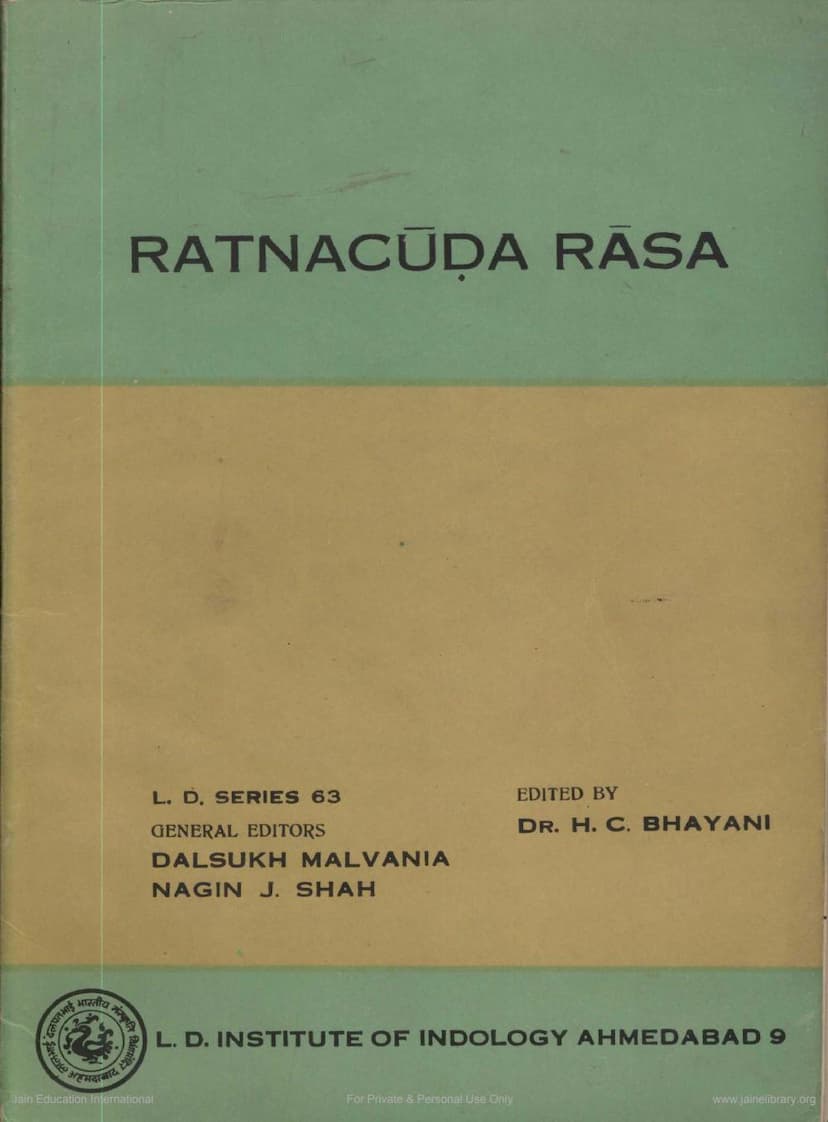Ratnachuda Rasa
Added to library: September 2, 2025

Summary
Here's a comprehensive summary of the Jain text "Ratnachuda Rasa" based on the provided pages:
Book Title: Ratnachuda Rasa Author: H. C. Bhayani Publisher: L. D. Indology, Ahmedabad Series: L. D. Series 63 Publication Date: First Edition, December 1977
Overall Summary:
"Ratnachuda Rasa" is a narrative poem from the 15th century (Gujarati calendar era), based on the "Rasa" genre. It is a didactic work presented in the form of a story, intended to convey moral and religious lessons, primarily within the Jain tradition. The text was edited by Dr. H. C. Bhayani, who meticulously compiled it from eight manuscript copies, providing variant readings and an introductory essay.
Key Aspects and Themes:
- Narrative Structure: The core of the text is the story of Ratnachuda, a merchant's son. The narrative is interspersed with numerous illustrative stories (drishtanta kathas) used to explain moral principles or to illustrate the wisdom of the characters.
- Moral and Didactic Purpose: The "Rasa" genre, especially in Jain literature, is often used for teaching. "Ratnachuda Rasa" aims to impart lessons on topics such as:
- The consequences of actions (karma): The story highlights how past deeds influence present and future circumstances.
- The importance of wisdom and intelligence: The protagonist, Ratnachuda, navigates challenges through his sharp intellect and understanding of human nature.
- The dangers of deception and greed: The text features characters who are deceitful and greedy, illustrating the negative outcomes of such traits.
- The value of virtue and righteous conduct: The narrative ultimately rewards virtuous behavior.
- The nature of the soul and its journey: The allegorical interpretation at the end suggests that the story represents the soul's journey through the cycle of rebirth and its eventual path to liberation.
- Illustrative Stories (Drishtanta Kathas): The book features several prominent illustrative stories:
- The story of Rohan, the dancer's son: This story highlights how intelligence can overcome perceived limitations and even fool wise individuals, demonstrating the power of sharp wit.
- The story of the wise minister who triumphs over destiny: This tale emphasizes how wise counsel and proactive measures can alter unfavorable destinies predicted by fate.
- The story of the "Wadhkani Sodhi" (contentious woman): This illustrates the consequences of arrogance and a lack of understanding, showing how a clever daughter-in-law can defeat her.
- The story of the four fools: This humorous narrative showcases various forms of foolishness, from misinterpreting advice to losing possessions through absurd reasoning.
- Allegorical Interpretation: The introduction suggests a deeper, allegorical meaning for the characters and events:
- Ratnachuda: Represents the worldly soul.
- Kutkataha Island: Symbolizes the world (samsara).
- The courtesan (Vesya): Represents spiritual guidance or the Guru's advice.
- The four merchants: Symbolize the four passions (Krodha, Mana, Maya, Lobha - anger, pride, delusion, greed).
- The carpenter's stool: Represents attachment and aversion (raag-dvesh).
- Ranaghanta: Represents intelligence and good speech (subhashita-buddhi).
- Yamaghanta: Represents false or deluded intellect (mithyatva-vrutti).
- Literary Significance:
- Rasa Genre: The text is a prime example of the "Rasa" composition, a form of narrative poetry often sung or recited, typically accompanied by music and dance.
- Language: It is an important work in Old Gujarati, showcasing its literary development.
- Manuscript Tradition: The editor's work highlights the extensive manuscript tradition, with variations contributing to the understanding of the text's transmission.
Content Breakdown (from the provided Index and content pages):
- Introduction (Bhumika):
- Base Manuscript Material: Discusses the various manuscripts used for the edition, their dates, and notable differences.
- Synopsis of the Story (Katha Sar): Provides a summary of Ratnachuda's journey, including his father's warning, his encounters with the deceitful merchants on Kutkataha Island, and his seeking of counsel.
- Illustrative Stories: Introduces the four key illustrative stories mentioned above, with detailed summaries.
- Ratnachuda Story Literature: Discusses other known works about Ratnachuda and their relationship to this "Rasa."
- Analysis of Certain Story Elements: Examines specific motifs like the fools' stories and their origins.
- The Main Text (Ratnachuda Rasa - Mool Path ane Pathantar): The poem itself, presented with the original text and variant readings.
- Appendices (Parishisht): Contains significant variant readings from a manuscript dated Samvat 1558.
- Glossary (Mahatva na Shabdo ni Suchi): A list of important words and their meanings.
- Errata (Shuddhipatra): A list of corrections.
Historical and Literary Context:
- Date of Composition: While some manuscripts suggest dates around 1501, 1509, or 1504 (Gujarati Samvat), the generally accepted date for the composition is around 1509 Samvat (1450-1453 CE).
- Author: The author is identified as a disciple of Ratnasuri of the Brihat Tapagachha. There's a discussion about the potential identity of the author and its relation to a Sanskrit work by Jnansagar.
- Publication: The L. D. Institute of Indology, Ahmedabad, published this critical edition, acknowledging financial assistance from the Government of Gujarat.
In essence, "Ratnachuda Rasa" is a rich Jain narrative poem that uses an engaging story and vivid illustrative tales to convey profound moral and spiritual lessons, rooted in the concepts of karma, wisdom, and righteous living. Its publication by L. D. Indology makes it accessible to scholars and readers interested in ancient Gujarati literature and Jain philosophy.